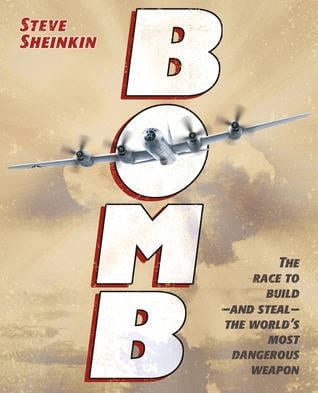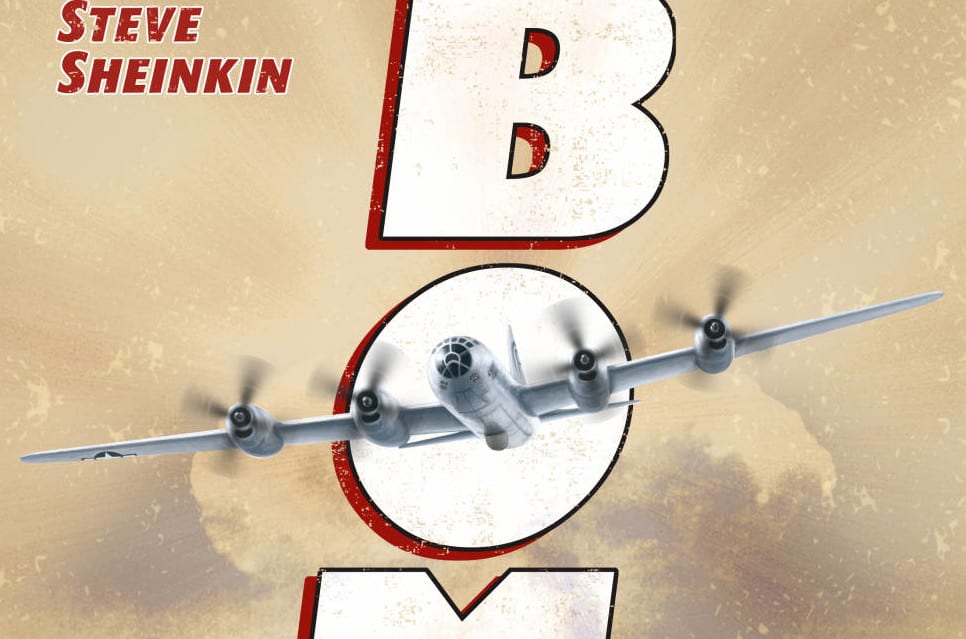
Book Review: “Bomb: The Race to Build—and Steal—the World’s Most Dangerous Weapon”
by Steve Sheinkin
Scholastic, 2012. 266 pages. Hardcover, trade paperback, all electronic formats and audio book formats.
We all know how this story ends. But that doesn’t make this book any less exciting, interesting, or important.
Steven Sheinkin is a historical writer who has written several titles for grade five up. I’ve already made note to two titles I want to read in the future. The Newberry Award-winning “Bomb” tells the story of the race to build the atomic bomb and the race to steal it.
The uninitiated, like me, may not realize that splitting the atom was discovered in late 1938 in Germany, just as Hitler was ramping up to begin World War II. It set the physics world on its collective ear. Everything physicists knew about atoms at that point said the discovery was impossible, but there it was for the world to see.
It set off a three-way arms race. Hitler immediately recognized the potential for an atomic bomb and started his top physicists working on the project. After Germany launched its blitzkrieg on Poland, the U.S. recognized the danger of an atomic Germany (even though they weren’t involved in the war at the time) and started working almost immediately on the bomb. And, well, the Russians didn’t want to be left out.
In the U.S., many of the top physicists, such as Albert Einstein and Robert Oppenheimer, were German and Jewish and not only recognized the need to prepare a defense against an atomic Germany but, as in the case of Oppenheimer, had Jewish family and friends in Germany who were being persecuted by Hitler and company. Einstein personally delivered a letter to President Roosevelt outlining the discovery and urging the U.S. to do everything possible to build the atomic bomb and prevent Nazi Germany from obtaining it.
The British also assembled a team of top physicists to help with the development of the bomb. Because London was under nightly bombing by the German Luftwaffe, it was decided that they would travel to the U.S. for safety and work with the American team with Oppenheimer at the head.
There were even three Italians involved: Enrico Fermi (everyone knows about him), Bruno Rossi, and Emilio Segre. Segre had Jewish roots and had moved to California to escape Fascist racial laws.
Sheinkin tells his story by focusing on three aspects of the development of the bomb, and three individuals who were key in those three aspects. In the development of the bomb, he focuses on Robert Oppenheimer, also known as the father of the atomic bomb. With the resistance side in Europe, he focuses on Norwegian resistance leader Knut Haukelid. Average American Harry Gold is at the center of the espionage story. In fact, Sheinkin starts the book with Gold’s capture and moves backward from there.
Just like a thriller writer, Sheinkin weaves stories throughout “Bomb,” switching between characters. Starting with Gold as he is about to be arrested, he then backtracks, introducing Oppenheimer as a skinny super hero and Haukelid as the daring and brash Norwegian resistence fighter who will do anything to liberate his country from the influence and control the Nazis and the Quisling government.
Though he was famously absentminded, Oppenheimer headed up the Manhattan project. (He once left his date in his car walked home, and went to bed, completely forgetting about her. His friends said that was typical of him.) He had a brilliant mind when it came to physics and science and viewed his efforts to build the atomic bomb as his personal fight against Hitler.
There were two kinds of spies: the hardcore communists who believed wholeheartedly in communism and the Soviet Union and would do anything to advance the cause (unfortunately, one of those turned out to be a physicist on the British team) and average Americans who got roped into helping because “the Russians are our allies, so why shouldn’t we share with them?”
Then there were the Norwegians. The attack on the heavy water factory in Norway is the stuff of action novels.
In fact, any aspect of this story could be turned into a hundred exciting and interesting books.
Before reading this, I didn’t realize the Germans surrendered just before the bomb could be used against them. But the Japanese dug in their heels, and that’s where the bombs were used.
Sheinkin is a consummate storyteller, weaving science into the story without talking over the readers’ heads and making it an interesting and exciting read. By using quotes from diaries and interviews, it also succeeds in giving readers a taste of the times. He leaves none of the major players out—from Oppenheimer’s assistant Dorothy McKibben at Los Alamos to Paul Tibbets, the pilot of the Enola Gay, or Ted Hall, the Russian spy who was never arrested.
He also reveals little known facts, such as secret cities scattered all across the nation. These cities were built by the government specifically to build the bomb with different aspects being done separately. Most if not all of the people in these cities had no idea that they were working on some part of the Manhattan Project.
Being an honest historian, he also includes the fallout of the bomb. It was discovered the U.S. was about two years ahead of Germany in the development of the bomb, and Stalin was furious that the U.S. beat Russia in developing the bomb.
But the fallout went beyond that. Afterwards, Oppenheimer realized that the bomb meant a worldwide arms race, and he urged the U.S. to cease developing atomic weapons. In fact, many of the people involved felt that same mixture of exhilaration at what they had accomplished and horror at the amazing destructive power they had unleashed on the world. This led to Oppenheimer being run out of town on a rail.
“Bomb” is exciting and deeply interesting from start to finish. Sheinkin is a gifted storyteller and historian. This is great for history buffs of all ages.




